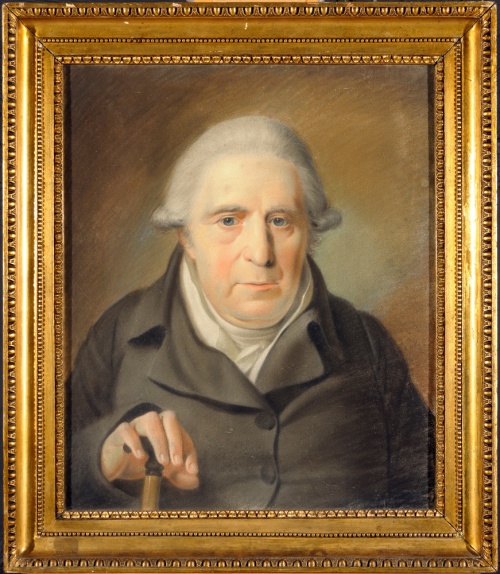Coninck, Frédéric de
Born 1740-12-5 in Den Haag, died 1811-9-4 on Dronninggaard in North Zealand.
Family
Father: Coninck, Jean (BioLek I)
Mother: Rapin, Susanne Esther de (BioLek I)
Brother: Coninck, Jean de 2 (BioLek II)
Marriage: 7 January 1770 in Haag to de Joncourt, Marie (22 July 1747 - 8 May 1821, died in Copenhagen). Marie de Joncourt was the daughter of the Royal Librarian and Councillor to the Prince of Oranje, Gertrude Louis de J. and Marie Madeleine Rachel (nee d'Amberbos) (Henningsen, 78)
Daughters: Pingel, Ane Marie; Coninck, Henriette de; Coninck, Louise de (FT-1787)
Sons: Coninck, Jean de 3; Coninck, Henry de; Coninck, Bellej? de (FT-1787)
Son-in law: Pingel, William (FT-1787)
Cousin: Cazenove, Charles de (PHT 1936:3)
Timeline
1757 - Employed at a British trading house in Amsterdam. (BioLek II)
1763 - Came to Copenhagen (BioLek I)
1763 - Became employed as supercargo at the Danish Asiatic Company in Canton, but decided otherwise just before departing. (BioLek II)
1765 - Citizenship as whole-sale merchant (BioLek I)
1768 - Royal Agent (BioLek II) (Hennings, 77 argues that with the appointment as agent, de Coninck was also made Justitsraad) & Director of [Generalmagasinet] (Hennings, 1900, 77 Royal Library)
1770 - Married Joncourt, Marie de
1775 - Founded the trading House of de Coninck & Reiersen with Reiersen, Niels Lunde, which lasted until 1790. They owned 64 ships (Henningsen, 77)
1776 - Director of the Asiatic Company (Hennings, 77)
1777 - Accountant/bookkeeper for the Asiatic Company (Hennings, 77)
1783 - Appointed Etatsraad
1787 - Co-owner of the Østersøisk-Guineiske Handelsselskab (Hennings, 77)
1788 - Made "ældste" of the French Reformist Church (Hennings, 77)
1790 - Founded his own company House of de Coninck & Co. (BioLek II)
1790 - Co-founded Groshandlernes nærmere Forening, which later evolved into Grosserer-Societetet
1795 (28 January) - Letter from de Coninck to Anker (re. the English Club and the Coalition Club, 1792-1797) (KB, Håndskrifts, Ny Kgl. Samling, 4, 692 (gl.))
1796-98 Sent 14 ships with contraband Dutch goods from Batavia to Europe - 10 ships were taken by the British. This was one of several incidents that led to the Battle of Copenhagen in 1801. (Beck 1981:276)
1807 - Accused of treason (november) but freed of all charged by the high court on 19 October 1809) (Henningsen, 77). In the original, slightly later publication by the jusrisdiction, through the kammeradvokat etc. by the name of Johan Martin Schønhender published in 1809, it becomes clear that the accusation of treason had to do with de Coninck allegedly having agreed to be appointed "feltkommisær", i.e. to accept a military position in the English army. This of course sat on the backdrop of the English bombardement of Copenhagen in 1807 (original source at the Royal Library: Proceduren for Commissionen samt Dommene og nogle Bilage i Sagen anlagt paa Justitiens Vegne imod de Herrer Grev Schulin, Etatsraad de Coninck, og Sognepræsten Rønne" by Schønheyder, Johan Martin (1809, Copenhagen)
1809 - Refused to accept the Order of Dannebrog (storkors) (Henningsen, 77)
1811 - Upon his death, de Coninck left 625.000 Rigsdaler, even if this was later reduced to 125.000 Rigsbandaler upon depts etc. having been paid (Werner, Duntzfelt)
1821 (approx.) - what was left of the merchant house [de Coninck & Co.] was bankrupted (BioLek II)
Property
1781 - Bought Dronninggaard in Northern Zealand, a former manor of Queen Sophie Amalie from 1661. De Coninck erected a new and large main building and in the five years transformed the surrounding area into a landscape garden, complete with a small island with a Chinese tea house. Near the main builing a column was erected carrying the inscription: "Til ære for handelen og søfarten som under en vis og mild regerings indflydelse og beskyttelse gav mig evne at forskønne dette sted og forbedre dets agerdyrkning". (Erichsen & Skak-Nielsen 2012, p.161). The Dronninggaard estate was bought for 18,500 daler courant (Henningsen, 77). In 1809 (20 December) he passed on ownership of Dronninggaard and the Kaningaard estate to his son (which one? - Jean?) (Henningsen, 77).
1783 - Purchased the estate on Nybrogade 12 (Henningsen, 77, Royal Library).
1785 - Bought Gyldenløves Small Mansion on the corner of Dronnings Tværgade and Bredgade in Copenhagen with Reiersen, Niels Lunde. (indenforvoldene.dk)
1788 - Became sole owner of Gyldenløves Small Mansion on the corner of Dronnings Tværgade and Bredgade in Copenhagen. Decorated the interior with wall paintings of his country manor, Dronninggaard, also called Næsslottet. Sold to the dowager Queen Juliane Marie in 1794 after the fire of Christiansborg Castle, who sold it to Brun, Constantin in 1798. (indenforvoldene.dk)
1798 - Owner of Kaningaard near Virum in northern Zeland (Henningsen, 77). He allegedly rebuild the estate originally erected on behalf of Queen Sophie Amalie, and did various work on the small island on which the estate sits (www.kaningaarden.dk). He renamed the rebuild estate Næsseslottet. Frederic de Coninicks son, Jean, lived on the estate for a number of years.

